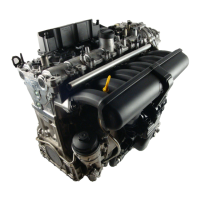Misfire diagnostic
If the fuel/air mixture does not burn correctly, then
the generated torque will be less than intended and the
engine rpm will drop suddenly, (decelerate) the engine
is said to be misring. The control module can detect
misring by measuring the time between successive
segments on the ywheel /carrier plate.
If there is a misre then there will be a stepchange
in the size of these successive time measurements, if
there is a misre the lost torque will be noticed as a
slowing down of the ywheel rotation. The prerequi-
site for reliable misre detection is accurate segment
period measurement. However, the period between
two top dead centers (TDC), at constant speed, is also
subject to variations due to manufacturing tolerances
and off center installation. These inaccuracies are sys-
tematic, so they can be “learned” during fuel cut off
periods and used for compensation. By this way, the
systematic error introduced by the tolerances of the
target ywheel is largely eliminated. The segment time
can vary due to the following reasons:
- Misring
- Flywheel mechanical tolerances
- Driveline oscillations
- Normal variations caused by uneven
combustion
- Poor roads.
Since mechanical tolerances and driveline oscillation
interfere with the signal, it is difcult to ascertain
whether or not this interference is due to misring. To
eliminate mechanical faults in the ywheel the ywheel
signal is adapted. Two crankshaft revolutions are divi-
ded into six periods, (on a 6 – cylinder engine), if the
engine has no external load all six periods should be
equal. This is to even out the signal, so that a mecha-
nical fault in the ywheel is not registeredas misring.
After adaptation there is someinterference in the signal
due to oscillations in the drive train and normal engine
irregularities.The ywheel signal is adapted when:
- Engine speed is between two targets
- The fuel shut-off system is operating and has been
active for 100 revolutions.
A DTC is stored when misring leads to increased
emissions and a DTC is stored when misring could
cause damage to the TWC. The engine control module
registers and stores the engine speed, load and warm-
up status in which the misring occurred. See part
”Diagnostic functions, Overview”.
If misre exceeds catalyst damage threshold, the sys-
tem will cut the fuel on those cylinders that experience
misre if one of the two following conditions are
fullled:
1. Misre on single cylinder
2. One or two cylinders misring all the time.

